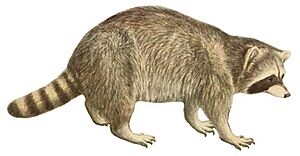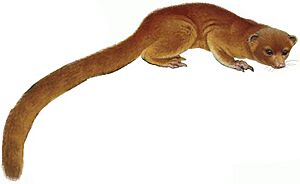Procyonidae facts for kids
Quick facts for kids Procyonids |
|
|---|---|
 |
|
| Common Raccoon | |
| Scientific classification | |
| Kingdom: | |
| Phylum: | |
| Class: | |
| Order: | |
| Suborder: | |
| Superfamily: |
Musteloidea
|
| Family: |
Procyonidae
Gray, 1825
|
| Genera | |
|
†Plesictis |
|
Procyonidae is a group of mammals that includes animals like raccoons, coatis, and kinkajous. These animals are found in the Americas, which is why they are called a "New World" family. They belong to the Carnivora order, which means they are related to other meat-eating animals.
Procyonids are known for being omnivorous, meaning they eat both plants and animals. They live in many different types of places, from forests to cities.
Contents
What Makes Procyonids Special?
Procyonids are usually small animals. Most of them have thin bodies and long tails. However, the common raccoon is a bit more chunky.
People sometimes think of procyonids as smaller relatives of bears. For example, in German, a raccoon is called a Waschbär, which means "washing bear," because it looks like it washes its food. A coati is a Nasenbär (nose-bear), and a kinkajou is a Honigbär (honey-bear). But scientists now believe procyonids are more closely related to mustelids (like weasels) than to bears.
Because procyonids eat many different kinds of food, their teeth are not as specialized for eating meat as those of other carnivores. They have special teeth called carnassials, but these are not as strong in most procyonid species, especially raccoons.
How Are Procyonids Classified?
Scientists have sometimes found it tricky to classify all the animals in the Procyonidae family. For a while, the red panda was thought to be part of this family. But now, thanks to studies of their DNA, we know that red pandas belong to their own family, the Ailuridae.
The different types of olingos also caused some confusion. Some thought they were all just different versions of one species. But DNA studies showed that they are actually different species.
Here is a simplified way to understand how procyonids are related, based on recent genetic studies:
|
Types of Procyonids
The Procyonidae family is divided into different groups, or genera, each with its own species.
- FAMILY PROCYONIDAE
- Raccoons, Coatis, Ringtails, and Cacomistles (nine species in four genera)
- Raccoons (Procyon genus)
- Crab-eating raccoon, Procyon cancrivorus
- Cozumel raccoon, Procyon pygmaeus
- Common raccoon, Procyon lotor
- Coatis (Nasua and Nasuella genera)
- Nasua
- Raccoons (Procyon genus)
- Raccoons, Coatis, Ringtails, and Cacomistles (nine species in four genera)
* South American coati or ring-tailed coati, Nasua nasua * White-nosed coati, Nasua narica
-
-
-
- Nasuella
-
-
* Western mountain coati, Nasuella olivacea * Eastern mountain coati, Nasuella meridensis
-
-
- Ringtails and Cacomistles (Bassariscus genus)
- Bassariscus
- Ringtails and Cacomistles (Bassariscus genus)
-
* Ringtail, Bassariscus astutus * Cacomistle, Bassariscus sumichrasti
-
- Kinkajous and Olingos (five species in two genera)
- Potos
- Kinkajou, Potos flavus
- Bassaricyon
- Northern olingo or Gabbi's olingo, Bassaricyon gabbii
- Eastern lowland olingo, Bassaricyon alleni
- Western lowland olingo, Bassaricyon medius
- Olinguito, Bassaricyon neblina
- Potos
- Kinkajous and Olingos (five species in two genera)
Family Tree of Procyonids
Scientists use molecular biology studies to understand how different animals are related. This "family tree" or phylogeny shows the relationships between the different procyonids.
| Procyonidae |
|
|||||||||||||||||||||||||||||||||||||||||||||||||||||||||||||||||||||||||||
See also
 In Spanish: Prociónidos para niños
In Spanish: Prociónidos para niños






